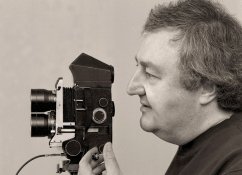My entry to medium format was the Mamiya TLR series--and it was a great way to get into it, in retrospect, so I'll add my voice to those recommending that system.
If you don't *want* to change lenses, just get one with the 80/2.8 and be happy. Or, if you prefer wider, get the 65--a really great lens--or 55; if you prefer longer, get the 105 or 135. (The 180 Super is a fantastic lens, too, but that may be a bit *too* long for general use.) So that's an advantage of the Mamiya system; you *can* stick with one lens, but you can choose the length you want, which isn't available on most TLRs.
I see some of the other advantages of the Mamiya TLR system have been mentioned above. The bellows is very nice, as it will allow you to focus much closer than an SLR would normally (although you have to deal with parallax in that case). Also, you don't have to worry about mirror slap/blackout/noise, like you would with an SLR. I don't have my Mamiya TLR anymore, I traded my kit in toward a Rolleiflex 2.8F (which I sometimes regret; I *love* the Rolleiflex, but it isn't as versatile as the Mamiya certainly--and it was way more expensive), but I like having a TLR for those occasions when I want to shoot silently, or when I want to be able to see the subject at the precise moment of exposure--I sometimes shoot dancers, often with strobes, and unlike with an SLR I can see exactly what position they were in when the shutter fired so I know if I got the shot or not.
Not only that, a TLR will fire the shutter practically *immediately* when you press the button. With an SLR, you have the delay caused by the whole sequence of shutter closing-mirror flipping up/aperture stopping down-shutter opening for exposure. So when I'm shooting with, say, a Hasselblad, I have to try to *anticipate* where the moving individual will be when the shutter actually fires in that process; and even then, I don't really *know* if I got them precisely where I wanted them. With a TLR, the "snick" of the shutter happens almost instantaneously when I fire the camera, and I can see in the viewfinder exactly (particularly with strobes) what was happening in front of the camera when the exposure was made.
Heck, even though they're reasonably priced nowadays and considered more "entry level" than other medium format cameras, the Mamiya TLR was good enough for Diane Arbus--and she would have to rank somewhere amongst the greatest photographic artists of all time.
(Oh, and to respond to Alan's message above--yes, *all* waist-level finders are reversed left-to-right. But even with TLRs, you can often get prisms for unreversed viewing--at least with Mamiyas and Rollieflexes you can, and you certainly can for nearly all SLRs with waist-level finders. It's easy enough to get used to the reversal, though--just move the camera the way you need to *in the viewfinder* to get the composition you want, don't worry about what's in front of the camera. I have a prism for my Hasselblad, but I almost never use it because I'm so used to using the technique I just mentioned. In fact, it crosses me up to use the prism, even though it is showing me things the right way around.)








